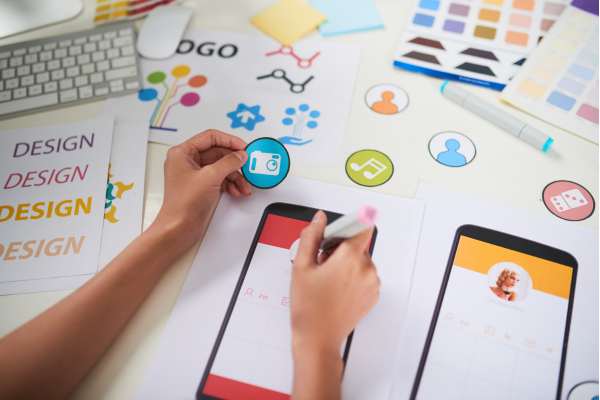In today’s visually driven world, a strong and consistent visual identity is crucial for businesses and brands seeking to make a lasting impression. A well-crafted visual identity encompasses various elements such as logos, color palettes, typography, and graphic elements, all working harmoniously to communicate a brand’s essence, values, and personality. This article explores the significance of visual identity design, the key components involved, and how businesses can develop a cohesive and impactful visual identity that resonates with their target audience.
I. Understanding the Importance of Visual Identity Design
A. The Role of Visual Identity in Brand Perception and Recognition A well-defined visual identity serves as the face of a brand, influencing how it is perceived by customers. It plays a pivotal role in brand recognition, helping customers identify and differentiate a brand from its competitors. A strong visual identity creates a sense of trust and familiarity, establishing a connection between the brand and its audience.
B. Establishing Brand Consistency and Cohesion A cohesive visual identity ensures that all brand elements work together seamlessly, creating a consistent brand experience across various touchpoints. From the logo to color schemes and typography, every element should align with the brand’s values, personality, and target audience. Consistency in visual identity strengthens brand recall and reinforces brand messaging.
C. Reflecting Brand Values and Personality Visual identity design allows brands to communicate their unique values, personality, and positioning. Through carefully chosen design elements, a brand can evoke specific emotions, establish a desired brand image, and resonate with its target audience. A thoughtfully crafted visual identity reflects the brand’s core values and helps build an emotional connection with customers.
II. Key Components of Visual Identity Design
A. Logo Design: Crafting a Distinctive and Memorable Brand Mark The logo is the centerpiece of a visual identity, serving as a visual representation of the brand. It should be designed to capture the brand’s essence and make a memorable impact. A well-designed logo incorporates symbolism, typography, and visual elements that align with the brand’s values and resonate with the target audience.
B. Color Palette Selection: Creating a Harmonious and Meaningful Color Scheme Colors evoke emotions and convey messages, making them a crucial component of visual identity design. Choosing a color palette that reflects the brand’s personality and resonates with the target audience is essential. Each color should have a purpose and convey the intended brand message effectively.
C. Typography: Selecting Fonts that Align with Brand Personality and Legibility Typography plays a significant role in visual identity design, as fonts convey the brand’s tone and personality. Selecting appropriate fonts that are legible and align with the brand’s values is crucial. A combination of fonts can be used to create hierarchy and establish a consistent visual language.
D. Graphic Elements: Enhancing Brand Identity with Visual Elements Graphic elements such as patterns, icons, and illustrations can enhance the brand’s visual identity and add depth to its communication. These elements should be consistent with the brand’s overall aesthetic and reinforce its messaging. They can be used across various brand collateral to create a cohesive brand experience.
III. The Visual Identity Design Process
A. Research and Brand Discovery Before embarking on visual identity design, thorough research and brand discovery are essential. Designers need to understand the brand’s target audience, values, personality, and industry landscape. Research helps uncover insights that inform the design process and ensure that the visual identity resonates with the brand’s intended audience.
B. Concept Development and Exploration Based on the research findings, designers begin developing concepts and exploring different design directions. This stage involves brainstorming ideas, sketching, and creating initial design mockups. It allows for experimentation and iteration to refine the visual identity’s core elements.
C. Iterative Design and Feedback Designers collaborate with the client to receive feedback and iterate on the design concepts. This iterative process helps refine the visual identity, align it with the client’s vision, and address any concerns or suggestions. Regular feedback sessions ensure that the final visual identity meets the client’s expectations.
D. Application and Guidelines Once the visual identity is finalized, designers create brand guidelines that outline how the visual elements should be used across different mediums. These guidelines ensure consistency in the application of the visual identity and provide clear instructions for its usage by internal teams and external partners.
IV. Achieving Visual Identity Consistency and Coherence
A. Internal Adoption and Implementation Successful implementation of the visual identity requires internal adoption and understanding. Educating employees and stakeholders about the brand’s visual identity guidelines ensures consistent usage and representation across various channels and touchpoints. It fosters a unified brand experience.
B. Monitoring and Adaptation Visual identity design is not static but evolves alongside the brand. Regular monitoring and evaluation of the visual identity’s effectiveness help identify areas for improvement or adaptation. As the brand evolves or expands, the visual identity may need to be adjusted to maintain consistency and relevance.
C. Continual Reinforcement of Brand Identity Consistency in visual identity requires continual reinforcement. Regular audits and assessments help ensure that the visual elements are consistently applied and align with the brand’s values. This reinforces the brand’s identity and helps build long-term brand recognition.
V. Showcasing Successful Visual Identity Design Examples
A. Case Study 1: How a Visual Identity Refresh Transformed a Brand’s Perception This case study examines how a brand’s visual identity redesign led to a significant shift in its perception and increased brand engagement. The strategic updates to the logo, color palette, typography, and graphic elements played a pivotal role in revitalizing the brand’s image and establishing a stronger connection with its target audience.
B. Case Study 2: Establishing a Visual Identity for a New Business Venture This case study explores the process of creating a visual identity for a startup, from research and concept development to implementation. The visual identity design helped establish a strong brand presence, differentiate the business from competitors, and attract the target audience. The cohesive visual identity played a crucial role in building brand recognition and trust.
Conclusion
Visual identity design is a fundamental aspect of brand development, enabling businesses to create a consistent and compelling visual representation. A well-crafted visual identity, encompassing logos, color palettes, typography, and graphic elements, communicates a brand’s values, personality, and positioning to its target audience. By understanding the significance of visual identity design, leveraging key components, and following a systematic design process, businesses can develop a visual identity that resonates with their audience, enhances brand recognition, and supports their overall brand strategy. Through consistent implementation and continual reinforcement, businesses can establish a visual identity that leaves a lasting impression and contributes to their long-term success in the competitive marketplace.



